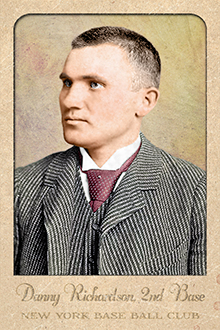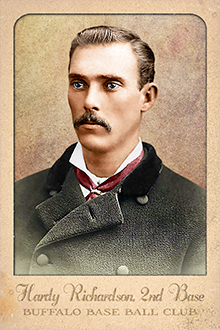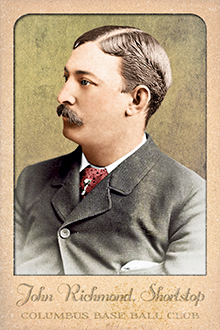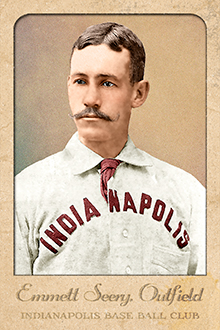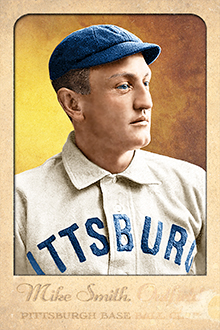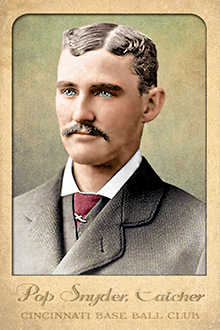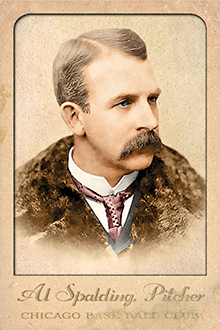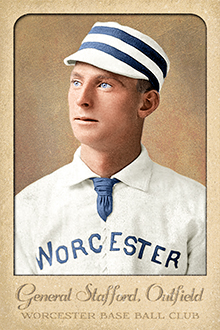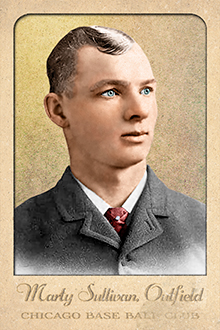- Series: Pioneer Portraits II: 1875-1899
- City: Providence
- Team: Grays (NL)
- League: National League
- Hall: National Baseball Hall of Fame
Charles Gardner Radbourn (1854-1897). An elite pitcher for 5 teams over 12 seasons, Radbourn owns the single-season Wins record with either 59 or 60 (sources vary) in 1884 – the year in which he became baseball’s 2nd triple Crown winner with 441 Ks & a 1.38 ERA. In 1884, Radbourn started 40 of his team’s last 43 games and won 36 of them. In the 1884 World Series, Radbourn started and won all three games, giving up only 3 runs. Including the postseason, Old Hoss won 62-63 games in 1884 and threw over 700 innings.
- NL Triple Crown: 1884
- NL Wins champ: 1883, 1884
- 309 career Wins
- Pitched no-hitter: 1883
- Elected to Hall of Fame: 1939
- Series: Pioneer Portraits II: 1875-1899
- City: New York
- Team: Giants
- League: National League
Daniel Richardson (1863-1926) played 2B and SS for the Giants, Grooms, Senators, and Colonels over an 11 year span. His stints with the NY Giants included one year when the team played in the Player’s League (’90). He contributed to two Giant league championships in ’88 & ’89.
- During his one year with the Washington Senators, Richardson was player/manager
- Achieved a career BA of .254 and stole 225 bases
- Series: Pioneer Portraits II: 1875-1899
- City: Buffalo
- Team: Bisons
- League: National League
Abram Harding Richardson (1855-1931). Primarily a 2nd baseman, Hardy played every position at one time or another, even going 3-0 as a pitcher. Playing for 6 different teams over 14 professional seasons, Hardy was an excellent hitter who retired with a .299 lifetime average. Hardy’s best season was 1890 when he hit .326, scored 126 Runs, knocked in 146 runs & stole 42 bases.
- Once hit a home run because the outfielder could not find the ball in the tall grass
- Bill James ranks him as the 39th best 2nd baseman all-time
- Series: Pioneer Portraits II: 1875-1899
- City: Columbus
- Team: Buckeyes
- League: American Association
John H. Richmond (1855-1898) played 8 seasons at SS and CF for 7 teams. He started with the Athletics in 1875 and closed his career with the Alleghenys in ’85. He played 4 years in the NL and 4 in the AA, compiling a modest .238 batting average.
- His two most productive years were toward the end of his career with Columbus: ’83-84
- Series: Pioneer Portraits II: 1875-1899
- City: Philadelphia
- Team: Athletics (AA)
- League: American Association
- Hall: National Baseball Hall of Fame
Uncle Robbie (1863-1934). A durable catcher for 17 seasons with 3 teams, Robinson is credited as the 1st to play directly behind the plate at all times. Uncle Robbie once caught 5 games in two days. He also had 7 hits & 11 RBI in a single game. After his playing days were over, Robinson went on to manage for 18 seasons.
- Won 3 NL pennants as player
- Won 2 NL pennants as manager
- Won 5 NL pennants as pitching coach
- Elected to Hall of Fame: 1945
- Series: Pioneer Portraits II: 1875-1899
- City: New York
- Team: Giants
- League: National League
- Hall: National Baseball Hall of Fame
“The Hoosier Thunderbolt” (1871-1942). In a 10 year career: (8) 20-win & (4) 30-win seasons; 5x strikeout & 2x ERA leader; won pitching’s Triple Crown in 1894. Rusie threw hard for the era, once hitting HOFer Hughie Jennings in the head, inducing a 4-day coma. This event was influential in increasing the pitching distance to 60’6″ from its original 50 feet.
- Once was traded for Christy Mathewson
- Suffered hearing loss due to line drive to the head
- Elected to Hall of Fame: 1977
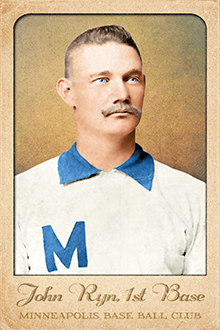
- Series: Pioneer Portraits II: 1875-1899
- City: Minneapolis
- Team: Millers
- League: Western Association
John Ryn (1862-1928) came out of Ohio and the Ohio Institute for the Education of the Deaf and Dumb, a nursery of some of the great baseball talent of the 1870s and 80s. A teammate of William Hoy and Edward Dundon, Ryn never followed them into the majors but floated on the periphery of the big leagues from 1884 to ‘95. The strapping first baseman had power and character but injuries and bad timing conspired to keep him in the minors. Hearing-impaired players made a significant imprint on the early game, none more so than Hoy, the “King of the Mutes” in the benighted lingo of sports scribes then. Ryn was able to carve out a pro career that spanned a dozen teams ending with the Twin Cities Hustlers of the Interstate League. The sketchy data indicate a .270 overall BA but press coverage consistently portrayed Ryn as a man to be reckoned with on the diamond.
- John and his sisters were deaf, their parents were not. A lifelong bachelor, Ryn made a living as a manual laborer and lived out his life with sister Anna in Marion OH
- Series: Pioneer Portraits II: 1875-1899
- City: Philadelphia
- Team: Quakers
- League: National League
Alexander Bennett Sanders (1865-1930) pitched for the Quakers, Athletics and Colonels over a 5 year career. His odd delivery left him facing 2nd base and vulnerable to the bunt. Nevertheless, Sanders went 80-70 with a 3.24 ERA. Perhaps his fielding limitations led to his yielding 2 runs despite hurling a no-hitter against the Orioles on 8/22/92 — the 1st no-no where the loser scored.
- Sanders joined the ill-fated Player’s League with Philadelphia in 1890
- As a rookie, nearly achieved a 2nd no-hitter, giving up a one-out single in the 9th
- Series: Pioneer Portraits II: 1875-1899
- City: Indianapolis
- Team: Hoosiers (NL)
- League: National League
John Emmett Seery (1861-1930) played the outfield for and with some of the game’s most colorful characters in the early era of baseball. He debuted with the Baltimore Monumentals in 1884. Seery led his Union League team in batting with a .311 BA. Played under John Montgomery Ward (Ward’s Wonders of Brooklyn) and Mike “King” Kelly (Kelly’s Killers of Cincinnati) during a tumultuous age as teams and leagues were starting and folding abruptly.
- In ’86 with the St Louis Maroons, led the league in games played with 126
- Followed the team’s owner, Henry Lucas, to Indianapolis with the Hoosiers for 3 years
- Demonstrating a good eye, consistently ranked in the top 10 in walks
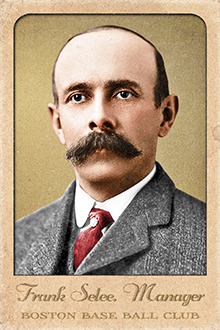
- Series: Pioneer Portraits II: 1875-1899
- City: Boston
- Team: Beaneaters
- League: National League
- Hall: National Baseball Hall of Fame
Frank Gibson Selee (1859-1909) was on the way to becoming the greatest baseball manager of all time when tuberculosis drove him out of the game he had mastered. For sixteen years, 1890-1905, Selee molded teams that found ways to win. He placed players on the field like a chess grandmaster, using their talents in ways they didn’t even recognize in themselves. He treated his players fairly and as men, not cogs in a machine. And they responded to him, setting records for games won. Frank’s Beaneaters won five titles. He went out to Chicago and rebuilt a floundering squad, recruiting the likes of Mordecai Brown and carefully putting together the pieces of a legendary infield. Illness forced him to pass the baton to Frank Chance, but it is clear that Chicago’s four pennants were a testament to Selee’s managerial acumen.
- Frank’s genius was in organizing men to get the best results from them. His players hit for power unlike any until the Babe’s Yankees yet also innovated many of the finesse plays: hit and run, hitting behind the runner, double-plays
- A dozen of Selee’s charges would precede him into Cooperstown
- Elected to Hall of Fame: 1999
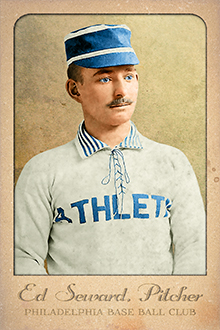
- Series: Pioneer Portraits II: 1875-1899
- City: Philadelphia
- Team: Athletics (AA)
- League: American Association
Edward William Seward (nee Sourhardt) (1867-1947) was just 20 years old when he teamed with Gus Weyhing on the mound as the Athletics’ formidable starting duo, combining for 51 of the team’s 63 wins. “Kid” Seward had begun in the minors at 16 so was something of a veteran when Philadelphia made him their ace. Ed started and finished 110 games in ’87 and ’88, winning 60. He was on fire in 1888, leading the American Association in strikeouts and shutouts while hurling a no-hitter against the Cincinnati Red Stockings on July 25. He went 35-19 with a 2.01 ERA. The phenom began to burn out the following year but still posted a strong 21-15 season. His final year with the A’s, 1890, saw the Kid fall off to 6-12. A brief look with the Cleveland Spiders the following year was his last, starting a mere three games and winning two. His mound-mate Weyhing matched his no-hitter a week after Ed’s. Nicknamed “Rubber Arm,” Weyhing indeed proved the more durable, going on to a 14-year career. Nevertheless, for a couple of seasons, these two strong-armed youngsters really lit it up in the city of brotherly love.
- Seward’s overall record was 89-72 with a 3.40 ERA and 589 strikeouts

- Series: Pioneer Portraits II: 1875-1899
- City: New York
- Team: Giants
- League: National League
John Henry Sharrott (1869-1927) debuted in professional ball at the top, with the New York Giants in 1890, winning 11 games. In ‘93 Jack moved to the Phillies where he ended his ML tenure going 4-2. He won 20 games in his four years with a respectable 3.12 ERA before turning to the minors and a managerial career. He led the Bangor team in 1894-95 and came back with the Ilion Typewriters (no kidding) in 1904 before ending his pro experience in Wilkes-Barre, also of the NY State League, in 1905-06. Jack was a spot starter in the outfield for various minor league teams where he compiled a .300 average in nine seasons. His best year was with the Bangor Millionaires (so ahead of their time) in 1894 where he hit .328 with ten HRs.
- Jack relieved old friend Jack Taylor in a Philadelphia/Brooklyn contest on July 27, 1893. A rookie came to bat and singled. The kid was George Sharrott and the writers were abuzz with the story of a first: “Brother gets a hit against brother in MLB debut.” Unfortunately, George was Jack’s cousin so the “record” lost some of its shine
- Series: Pioneer Portraits II: 1875-1899
- City: Pittsburgh
- Team: Pirates
- League: National League
Elmer Ellsworth "Mike" Smith (1868-1945) pitched well enough to lead the AA in ERA in 1887 for Cincinnati, but after 3 years on the mound his bat dictated a shift to the outfield. Traded to the Pirates in ’92, Smith was an impact player, hitting 136 triples and 37 HRs over his 14-year career. His three-baggers tied Babe Ruth’s lifetime total.
- His remarkable but brief pitching record included 122 CG in 136 starts with 9 shut-outs
- In his great ’87 season, Smith started 52 games, completed 49 and went 34-17
- Series: Pioneer Portraits II: 1875-1899
- City: Cincinnati
- Team: Red Stockings (AA)
- League: American Association
Charles N. Snyder’s (1854-1924) 18 year career was bookended by Washington clubs: the Blue Legs of the NA and the Statesmen of the AA. As a catcher, he set many records. He won the inaugural championship of the American Assoc in 1882 as player-mgr w/Cincinnati. He was also on the pennant-winning Boston Red Caps in ’78.
- Umpired for the Players’ League in ’91; went on to officiate in 4 leagues
- Records included putouts, assists, double plays and fielding %, all as catcher
- Series: Pioneer Portraits II: 1875-1899
- City: Cleveland
- Team: Spiders
- League: National League
“The Deerfoot of the Diamond” (1871-1913). A Maine native & son of a Penobscot chief, Sockalexis was one of the most gifted athletes ever to play the game. A pioneering Native American, Sockalexis endured intimidation and abuse throughout his all-too-brief career. He starred for the Fighting Irish before joining the Cleveland Spiders in 1897. His legacy lives today whenever the Cleveland Indians take the field—many believe that mascot to be a post-mortem tribute to this early star.
- Harvard professors measured his throw at 414′
- While at Notre Dame, he homered in the Polo Grounds off future Hall of Famer Amos Rusie
- John McGraw called him the “greatest natural talent” he had ever encountered in the game
- Series: Pioneer Portraits II: 1875-1899
- City: Chicago
- Team: White Stockings
- League: National League
- Hall: National Baseball Hall of Fame
Albert Goodwill Spalding (1850-1915) was an elite pitcher who retired at age 27 and proceeded to influence the game as few others have. He helped organize the NL, co-founded A.G. Spalding sporting goods, published the game’s first official rules, traveled the world to promote baseball, owned the White Stockings and led an Olympics, leaving one of the great legacies in sport.
- Was a five-time pennant winner with the Boston Red Stockings and Chicago White Stockings
- Career 252-65 record with a .796 winning percentage
- Elected to Hall of Fame: 1939
- Series: Pioneer Portraits II: 1875-1899
- City: Worcester
- Team: Grays (ATLA)
- League: Atlantic Association
James Joseph Stafford (1868-1923) was a versatile defensive player at OF, 2B and SS breaking into MLB in the Players’ League in 1890, then with the Giants, Colonels, Beaneaters and Senators from 1893-99. His one league championship was with Boston in ’98. Stafford’s brother John played for the Cleveland Spiders in 1893.
- Stafford’s career BA was .274
- Best output came in Louisville in 1897 when he had the NL’s 6th best HR total with 7
- Series: Pioneer Portraits II: 1875-1899
- City: Boston
- Team: Beaneaters
- League: National League
Charles Sylvester Stahl (1873-1907) was “the game’s most outstanding frosh hitter” in 1897 with the Boston Beaneaters. He led all rookies that year in 11 categories and still holds the Boston franchise record for 1st-yr players with a .354 BA. By 1904 he had been part of 4 champions in 7 years. His inexplicable suicide left his players in shock and grief.
- Succeeded as mgr by Cy Young who said “Players may come and go, but there are few Chick Stahls.”
- Series: Pioneer Portraits II: 1875-1899
- City: Chicago
- Team: White Stockings
- League: National League
Martin C. Sullivan (1862-1894) played outfield for four teams over five years from 1887-91. His first two seasons were with the Chicago White Stockings where he got into 190 games and even pitched in relief in one. He moved on to the Indianapolis Hoosiers in 1889, spent part of the next two seasons with the Beaneaters before ending his ML tenure with one game for the Cleveland Spiders.
- His lifetime BA is variously reported as .256, .273 and .288 showing the variance in data in that era
- Series: Pioneer Portraits II: 1875-1899
- City: Chicago
- Team: White Stockings
- League: National League
William Ashley Sunday (1862-1935) was born into extreme poverty and rose to become a beloved pro player making a handsome salary. In 1891 he gave that all up to pursue Christian ministry, cutting his income by two-thirds. Al Spalding had signed Sunday to his Chicago White Stockings on the recommendation of Cap Anson in 1883. His speed was his greatest asset.
- In ’85 Chicago held an exhibition with Sunday racing the speediest AA player. Billy won easily.
- His integrity and popularity led Anson to name Sunday the team’s business manager
- Sunday was recruited for the Players’ League in 1890, but remained loyal to his employer
- Series: Pioneer Portraits II: 1875-1899
- City: Boston
- Team: Beaneaters
- League: National League
Ezra Ballou Sutton (1849-1907). A 3rd baseman & shortstop, Sutton played for 5 teams over 20 seasons. Ezra was the 1st player to hit a home run in Major League baseball, and became the 1st player to hit 2 HRs in one game when he hit his second that day (in a losing effort). Sutton was also one of the 1st ball players to collect 1,000 career hits.
- Played in 1st National Association game: 5.4.71
- Played in 1st National League game: 4.22.76
- Lifetime .294 batting average
- Sutton is tied with 17 other players as the first player in major league baseball history
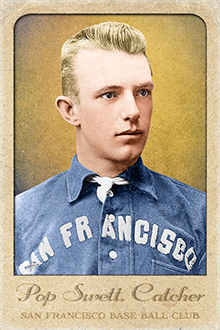
- Series: Pioneer Portraits II: 1875-1899
- City: San Francisco
- Team: Haverlys
- League: California League
William Edward Swett (1870-1934) had impressed major-league scouts with his performance in his hometown of San Francisco. The young catcher showed great fortitude by catching all but four of the ‘88 Haverlys’ 95 games. One report noted: “He throws like a rifle shot and has any amount of nerve.” Such publicity prompted the Boston Reds to offer him $2800 to join the Players’ League franchise. This amount was said to be the most ever paid to that time to land a California recruit. Swett saw limited service for King Kelly’s 1890 champions; the league folded, and “Pop” went home. Clearly, he preferred to be a highly-regarded player out west to being overshadowed in the the big leagues. In ‘93 The Sporting Life said of him: “without doubt one of the best catchers on the coast.” Nevertheless, Swett’s commitment to the game was lacking. He took a bailiff’s job in SF, tried once more with Nashville but was out of shape. In any event the team, like the Players’ League, folded in July ‘94.
- In his only major-league season, Swett hit .191 with a HR. In seven minor league seasons he hit .238
- It is unknown how the boyish blond acquired the nickname in his early 20s
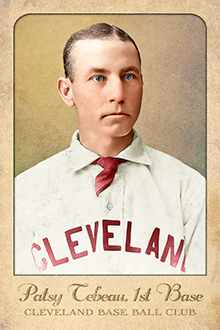
- Series: Pioneer Portraits II: 1875-1899
- City: Cleveland
- Team: Spiders
- League: National League
Oliver Wendell Tebeau (1864-1918) played first and third-base for five ML teams from 1887-1900. He was player-manager for three of those clubs 11 of his 13 seasons, squaring off with his arch-rival John McGraw and his Orioles. Tebeau led Cleveland during the rough-and-tumble era closing the 19th century. His obituary said he belonged to “the blood and iron brigade of baseball.” It was said that when the Spiders and Orioles met, “wild war raged up and down the field.” The august founding father of the game, Henry Chadwick, wrote in 1896 that Tebeau “degraded the game more than any player of the previous quarter century.” But the Cleveland fans loved Patsy and the League’s attempts to silence him soon faded.
- After retiring from the diamond, Tebeau ran a successful saloon in St. Louis
- Patsy couldn’t endure his wife’s decision to leave him and take the kids back to Cleveland. After his death at his own hand the local paper headlined: “Patsy Tebeau Acts as His Own Umpire”
- Series: Pioneer Portraits II: 1875-1899
- City: Chicago
- Team: White Stockings
- League: National League
John Kinley Tener (1863-1946). Born in Ireland, Tener won 25 games for 3 teams over 4 seasons. In 1888, on Spalding’s world baseball tour, John was chosen to explain baseball to the Prince of Wales, later King Edward VII. At home, Tener was elected Secretary of John Ward’s pioneering player’s union, the Brotherhood of Professional Players. John became the 25th Governor of Pennsylvania, serving from 1911-15 & also served as NL president from 1913-18.
- Organized 1st Congressional Baseball Game, now an annual tradition
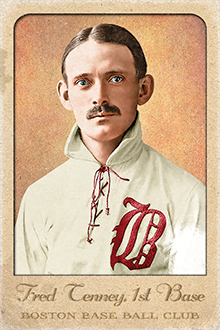
- Series: Pioneer Portraits II: 1875-1899
- City: Boston
- Team: Beaneaters
- League: National League
Frederick Tenney (1871-1952) built a twenty-year career in pro baseball, most of it in the major leagues and mostly in Boston. As a catcher, Tenney led his Brown University team to a “national championship” according to Harper’s Weekly in 1894. His play caught the attention of the Boston Beaneaters and he was signed to play for future Hall of Fame manager Frank Selee who developed Fred into a premier first-sacker. Through his friendship with Boston owner Arthur Soden, Tenney remained a loyal and evermore valued player-captain-manager and jack of all trades. His career as manager was lackluster in winning percentage but Fred was popular and the club made money, his and the team’s main objective. Sold to the Giants in 1908, Tenney had a great season at bat. Ironically, the sole game he missed that year was on September 23 when Fred Merkle subbed for him. The ensuing “boner” cost this great player his only shot at a World Series.
- Tenney was called the “Soiled Collegian” signifying his era’s disdain for university grads playing such a tawdry game
- The durable infielder holds the record for leading the NL in assists eight times, including seven straight years 1901-07

